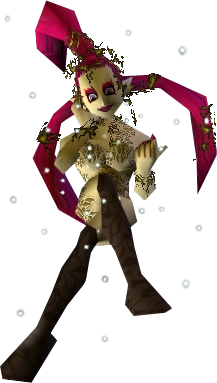Fairies in The Legend of Zelda have always been more than just magical creatures — they’re lifelines, guides, guardians, and, at times, eccentric mysteries. Across the franchise, they’ve appeared in many forms: ethereal spirits stored in glass bottles, divine beings blessing Link with sacred powers, and even fully-fledged companions with personalities and backstories. These beings are woven so deeply into Zelda’s identity that it’s difficult to imagine a world of Hyrule without them.
Companions of Courage: The Fairy Guides

Fairy companions in Zelda often act as a bridge between player and game world. The most iconic, Navi from Ocarina of Time, set the template: floating just over Link’s shoulder, offering tips, lore, and combat help. While her persistent voice and the now-infamous “Hey! Listen!” became meme-worthy, she was Nintendo’s answer to making a 3D Hyrule feel approachable.
Later iterations of fairy companions, like Tatl in Majora’s Mask, shifted the tone. Tatl’s sassier personality and brotherly connection to Tael added an emotional depth missing from Navi. In fact, Majora’s Mask places fairies front and center in its story — Tatl is essential to the narrative arc, and the mysterious Stray Fairies play a pivotal role in dungeon rewards, eventually helping you unlock the awe-inspiring Great Fairy Sword.


One of the most underappreciated companions is Ciela, from Phantom Hourglass. Unlike Navi and Tatl, Ciela is more than just a helper — she is eventually revealed to be the Spirit of Courage, tying directly into Hyrule’s divine lore. Her role as both guide and sacred force reflects the evolving complexity of fairy characters during the DS era.
Zelda Central Fact: The Nintendo DS stylus became part of Ciela’s design, turning her into the literal pointer for the player’s touch-based navigation — making her arguably the most interactive fairy in Zelda history.
The Great Fairies: From Sprites to Spirits
Great Fairies have transformed dramatically from game to game. In the 8-bit original, they were humble healers; in A Link to the Past, they became upgrade vendors hidden within Hyrule’s secret corners. But it was the N64 era where Great Fairies became memorable — and divisive.

In Ocarina of Time and Majora’s Mask, these characters were visually overwhelming: towering, laughing, shrieking beings with exaggerated designs, glittering hair, and bold stage presence. Despite the discomfort they caused some players, they represented a major design leap — magical women tied to the Triforce themes of Power, Wisdom, and Courage.
By the time The Wind Waker launched, Nintendo radically reimagined their look. The Great Fairies here resemble serene deities, some with multiple arms, vibrant colors, and calm expressions. Their aesthetic draws on Hindu and Buddhist visual motifs — a striking contrast to the flamboyance of their predecessors. Notably, Wind Waker introduced the Fairy Queen, depicted as a childlike divine being with immense magical strength.
Zelda Central Insight: The Queen of Fairies is the only character in The Wind Waker to explicitly mention her royal status over other fairies, making her arguably the most powerful fairy across the sea-faring Zelda titles.
In Breath of the Wild, the Great Fairies got bigger — literally. The four sisters (Cotera, Mija, Kaysa, and Tera) reside in massive blossom-like fountains, and each grows increasingly extravagant in appearance and personality as Link offers more rupees. A fifth entity, Malanya, is known as the Horse God and resides in a similar fountain. While the game doesn’t call Malanya a fairy outright, official guides refer to him as the Horse Fairy, suggesting a rare male counterpart to the Great Fairies.
Bottled Fairies: Zelda’s Magical Lifesavers

Fairies aren’t just characters — they’re some of Zelda’s most iconic items. First appearing in The Legend of Zelda (1986), wild fairies have been collectible companions that automatically revive Link when he falls in battle. Capturing one in a bottle has long been a strategy for survival — and a testament to the series’ magical realism.
Yet, this mechanic raises questions. Are the fairies willing participants? Do they feel pain? The Wind Waker subtly addressed this with distressed facial animations in bottled fairies, while Breath of the Wild sidesteps the issue by using “fairy essence” for cooking recipes — a gentler interpretation.
In a fun reversal, Hyrule Warriors even allows the Great Fairy to wield Link in battle — literally carrying him in a bottle, flipping the dynamic and highlighting the quirky humor Zelda fans love.
Collectible Magic: Stray Fairies & Dungeon Lore

Fairies also serve as dungeon-based collectibles. In Majora’s Mask, each major temple contains 15 Stray Fairies, whose return to a Great Fairy fountain results in major upgrades — such as enhanced magic, defense, or weapons. Unlike typical items, these fairies speak, glow, and emote, making them feel alive even in their fragmentary state.
In Twilight Princess HD, Nintendo added a new collectible mechanic via the Fairy Tears side quest. Once players help the Great Fairy at the Cave of Ordeals, they’re rewarded with Great Fairy’s Tears — the most potent healing potion in the game.
Tingle: Hyrule’s “Fairy” Enthusiast

We can’t talk about fairies in Zelda without acknowledging the green-clad enigma: Tingle. Introduced in Majora’s Mask, Tingle claims to be a reincarnated forest fairy, despite being a grown man with a balloon and a map obsession. His bizarre charm led to multiple appearances — including The Wind Waker, where he runs a chart decoding business (and possibly a criminal operation from his private island).
Zelda Central Trivia: Tingle is one of the few Zelda characters to get his own spinoff series, including Freshly-Picked Tingle’s Rosy Rupeeland and Ripened Tingle’s Balloon Trip of Love — though most of them never left Japan.
The Future of Fairies in Zelda
With Tears of the Kingdom expanding on Breath of the Wild’s foundation, fans are wondering: what’s next for fairies in Zelda? Will we see a return to companion-style fairies like Navi or Ciela? Will new fountains be discovered across Hyrule and the skies above? Could we even see a game where Link is a fairy?





